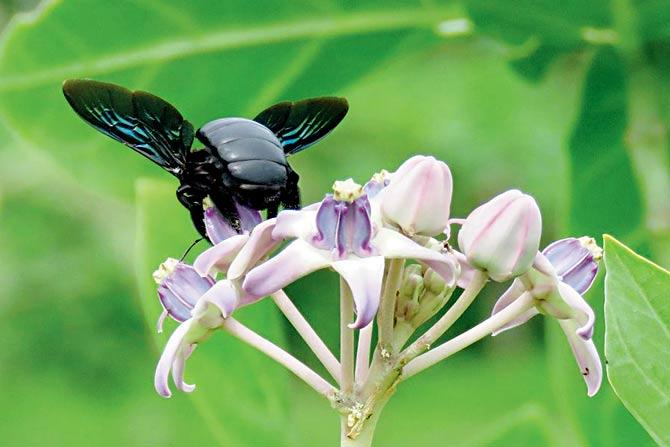Last weekend, a motley bunch of kids and adults attended a tree-trail at the Pramod Mahajan Kala Udyan, a newly landscaped garden at Dadar (West).

 Last weekend, a motley bunch of kids and adults attended a tree-trail at the Pramod Mahajan Kala Udyan, a newly landscaped garden at Dadar (West). The expert, Katie Bagli led the participants around the garden, narrating stories related to the park's trees. As someone who has led similar trails over the years, I'm aware of the difficulty involved in leading a mixed audience. Although everyone enthusiastically congregates to attend a tree-trail, it is a herculean task for the group leader to sustain their interest for over two hours, in trees and plants alone. So, automatically, associated species of vertebrates and invertebrates which pollinate, disperse or consume these trees are also explained.
Last weekend, a motley bunch of kids and adults attended a tree-trail at the Pramod Mahajan Kala Udyan, a newly landscaped garden at Dadar (West). The expert, Katie Bagli led the participants around the garden, narrating stories related to the park's trees. As someone who has led similar trails over the years, I'm aware of the difficulty involved in leading a mixed audience. Although everyone enthusiastically congregates to attend a tree-trail, it is a herculean task for the group leader to sustain their interest for over two hours, in trees and plants alone. So, automatically, associated species of vertebrates and invertebrates which pollinate, disperse or consume these trees are also explained.
Somewhere mid-trail, Katie showed some dead insect specimens, which she had painstakingly preserved. The colours of some of these were fascinating. The shiny black, robust carpenter bee was recognised by almost everyone, although they called it a bumble bee. This specimen brought back childhood memories when we scampered covering our ears at the sight of a buzzing black bee.
ADVERTISEMENT

An Indian carpenter bee on Jamaican spike flowers
Undergraduate studies revealed that we were misinformed and these carpenter bees neither entered ears nor bore holes in our bodies.
Carpenter bees have a wide global distribution and are called bhanvra in Hindi. Just like honey bees, they too are insects belonging to the Family Apidae. The carpenter bee is often confused with its close relative, the bumble bee, which is commonly seen in temperate regions (higher altitudes and latitudes). The larger carpenter bees are characterised by bald heads. There over 500 species of carpenter bees and all belong to the Genus Xylocopa, meaning wood-cutter, a name derived from ancient Greek. Taxonomically, the species are difficult to distinguish since most are either all-black or primarily black with yellow pubescence.
Architects and horticulturists tend to exterminate them with the belief that carpenter bees eat into wooden rafters or damage living plants. They don’t eat wood but simply bore holes in dead wood, or bamboo to build nests and lay eggs. In Mumbai, it’s not uncommon to see them nesting in hollow metal clothes’ rods. Females possess a sting and build the nest, whereas males are stingless and are often seen hovering around the nest. Traditionally considered solitary, some species are social wherein mother and daughters co-habit and share foraging and egg-laying tasks. Some carpenter bees and mites share a mutualistic association wherein the mites live in a specialised body part called acarinarium and benefit by feeding on fungi or control other harmful mites inside the nest.
Carpenter bees are important pollinators of open-faced flowers but rob nectar from deep tubular flowers by piercing the petals from sides without pollinating. Their tuning-fork buzzing sound caused by strong thoracic muscles is unmistakable. They usually shake and buzz when drinking nectar on flowers, hence the term buzz-pollination. Carpenter bees may scare kids, but they are voraciously preyed on by bee-eaters, drongos, woodpeckers, some mammals, large flies or maggots of parasitic flies which survive on the bee’s larvae.
Considering the important ecological service they provide, it would be inappropriate to dismiss carpenter bees as mere wood-borers. So, pick up your cameras and head to the Sanjay Gandhi National Park, Maharashtra Nature Park or the Veermata Jijabai Bhosle Udyan to click photos of these buzzing pollinators.
Write in to Anand at sproutsenvttrust@gmail.com
 Subscribe today by clicking the link and stay updated with the latest news!" Click here!
Subscribe today by clicking the link and stay updated with the latest news!" Click here!







